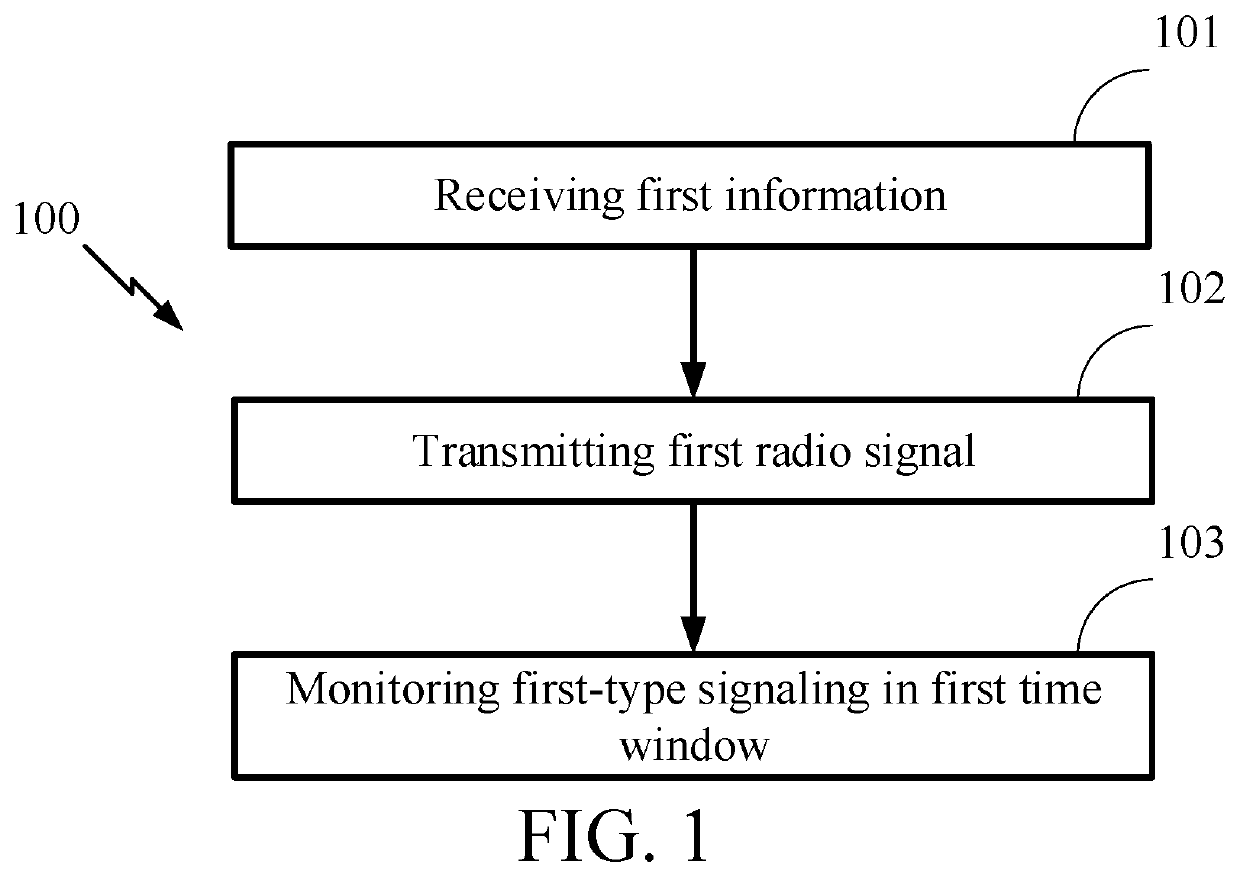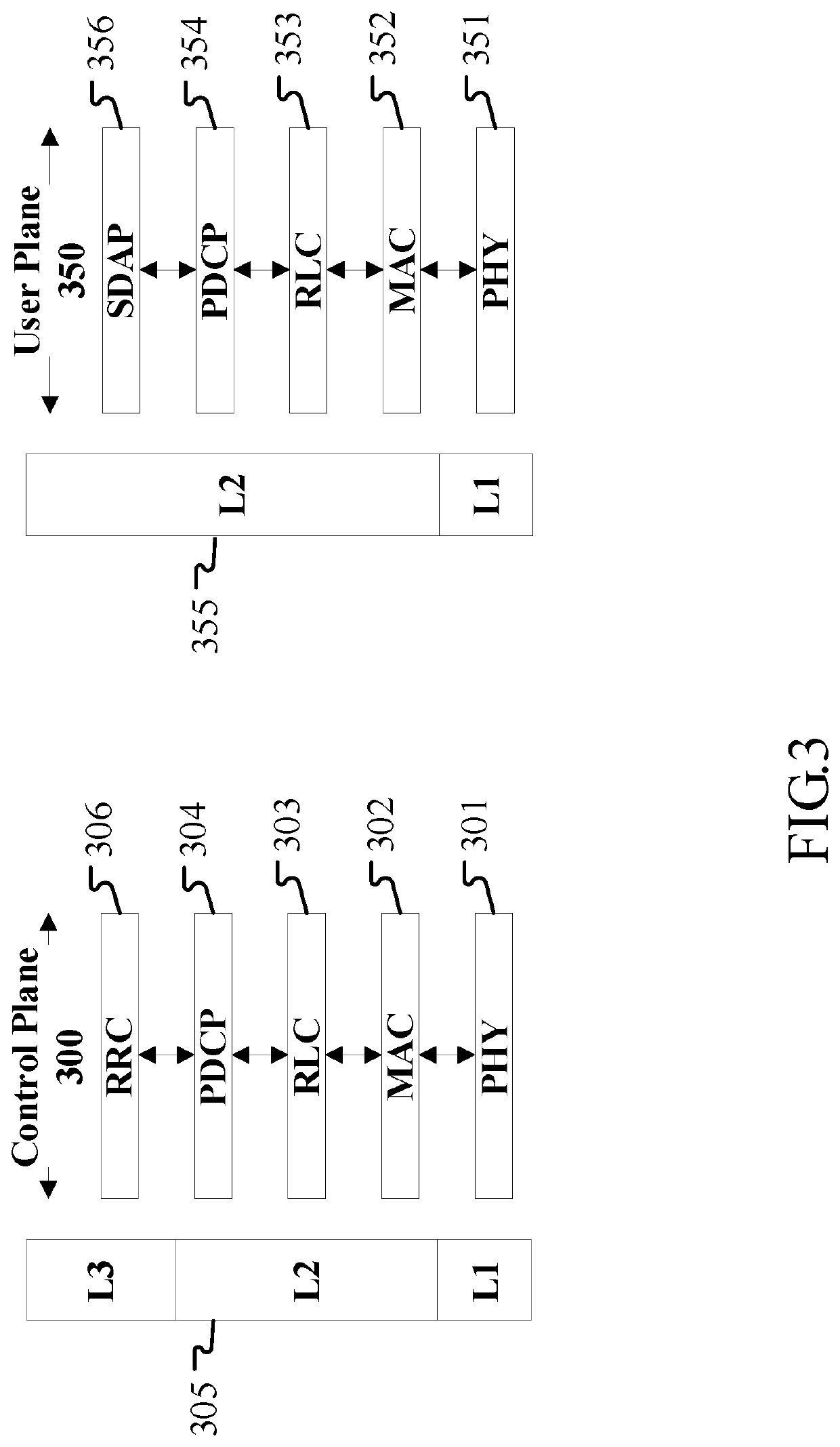Method and device in communication nodes used for wireless communication
- Summary
- Abstract
- Description
- Claims
- Application Information
AI Technical Summary
Benefits of technology
Problems solved by technology
Method used
Image
Examples
embodiment 1
[0085]Embodiment 1 illustrates a flowchart of first information, a first radio signal and a first-type signaling according to one embodiment of the present disclosure, as shown in FIG. 1. In FIG. 1, each box represents a step. It should be noted that the order of each box does not necessarily mean the time sequence of steps represented hereby.
[0086]In Embodiment 1, the first communication node in the present disclosure receives first information in step 101; transmits a first radio signal in step 102; monitors a first-type signaling in step 103; an end time for a transmission of the first radio signal is used for determining a start of the first time window, time domain resource occupied by the first radio signal is used for determining a first characteristic identity; the first characteristic identity is one of M characteristic identities, M is a positive integer greater than 1, the first information is used for determining the M characteristic identities; the first-type signaling ...
embodiment 2
[0200]Embodiment 2 illustrates a schematic diagram of a network architecture according to the present disclosure, as shown in FIG. 2. FIG. 2 is a diagram illustrating a network architecture 200 of 5G NR, Long-Term Evolution (LTE) and Long-Term Evolution Advanced (LTE-A) systems. The 5G NR or LTE network architecture 200 may be called an Evolved Packet System (EPS) 200. The EPS 200 may comprise one or more UEs 201, an NG-RAN 202, an Evolved Packet Core / 5G-Core Network (EPC / 5G-CN) 210, a Home Subscriber Server (HSS) 220 and an Internet Service 230. The EPS 200 may be interconnected with other access networks. For simple description, the entities / interfaces are not shown. As shown in FIG. 2, the EPS 200 provides packet switching services. Those skilled in the art will find it easy to understand that various concepts presented throughout the present disclosure can be extended to networks providing circuit switching services or other cellular networks. The NG-RAN 202 comprises an NR node...
embodiment 3
[0207]Embodiment 3 illustrates a schematic diagram of an embodiment of a radio protocol architecture of a user plane and a control plane according to the present disclosure, as shown in FIG. 3. FIG. 3 is a schematic diagram illustrating an embodiment of a radio protocol architecture of a user plane 350 and a control plane 300. In FIG. 3, the radio protocol architecture for a control plane 300 between a first communication node (UE, gNB, or, satellite or aircraft in NTN) and a second communication node (gNB, UE, or, satellite or aircraft in NTN), or between two UEs is represented by three layers, which are a layer 1, a layer 2 and a layer 3, respectively. The layer 1 (L1) is the lowest layer which performs signal processing functions of various PHY layers. The L1 is called PHY 301 in the present disclosure. The layer 2 (L2) 305 is above the PHY 301, and is in charge of the link between the first communication node and the second communication node, and between two UEs via the PHY 301...
PUM
 Login to View More
Login to View More Abstract
Description
Claims
Application Information
 Login to View More
Login to View More - R&D
- Intellectual Property
- Life Sciences
- Materials
- Tech Scout
- Unparalleled Data Quality
- Higher Quality Content
- 60% Fewer Hallucinations
Browse by: Latest US Patents, China's latest patents, Technical Efficacy Thesaurus, Application Domain, Technology Topic, Popular Technical Reports.
© 2025 PatSnap. All rights reserved.Legal|Privacy policy|Modern Slavery Act Transparency Statement|Sitemap|About US| Contact US: help@patsnap.com



